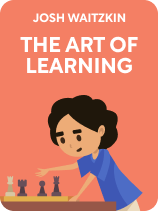

This article is an excerpt from the Shortform book guide to "The Art of Learning" by Josh Waitzkin. Shortform has the world's best summaries and analyses of books you should be reading.
Like this article? Sign up for a free trial here .
How do you read your opponent in a fight or a competition? What signals can help decipher their intended actions?
At the highest level, competition takes place on the psychological battlefield. To win, you have to learn how to read your opponent and exploit the chinks in their mental armor. This is especially true when you’re evenly matched in technique.
Here’s how to read your opponent, according to American chess player Josh Waitzkin.
Learn to Read and Not Be Read
We all have “tells,”—unconscious habits that give away how we’re feeling or indicate what we’re going to do. Waitzkin emphasizes the importance of “reading” the tells of your opponents.
You can study tells by paying attention to your competitors in and out of competition:
- In competition, look for things such as their breathing patterns, blinks that precede movement, and whether they get emotional mid-competition.
- Outside of competition, Waitzkin suggests that many competitors obliviously reveal aspects of their psychology—for example, you might notice that a rival of yours gets impatient over lunch between matches or frustrated with hotel accommodations.
(Shortform note: In poker, you can study your opponent at the table and elsewhere. At a live table, pay attention to opponents’ eyes, how they handle their chips and react to their cards, and whether they sound nervous in casual table talk. Outside of the game, Waitzkin’s tips hold true—paying attention to how they eat, how they converse, and how they conduct themselves can reveal psychological traits that you can exploit in the game. For example, you might find that they’re often overconfident at social events, and that translates to recklessness at the poker table.)
Waitzkin doesn’t say explicitly how to train this observational ability, but we can infer that it takes repeated practice. Whether you’re studying tai chi, chess, poker, Go, or whatever else, getting a dedicated practice partner helps familiarize you with common tells and twitches that may give away your opponent’s mind state.
Observing your opponents tells is a great way to prepare for competition. Understanding who your opponents are emotionally helps you exploit their specific weaknesses.
(Shortform note: While it may seem like studying your opponent’s psychology outside of the arena is ruthless, such gamesmanship is not typically against the rules. It stretches them, highlighting the fact that you need to push the limits to become the best. This level of intensity prioritizes winning, rather than enjoyment, which might contradict Waitzkin’s earlier recommendation to focus on the process. On the other hand, he might view it as an extension of the process—assuming part of your process is to become the best in the world. It really depends on how far we each want to take our skills.)
While it’s great to know how to read your opponents, it’s crucial to mask your own state of mind. If you’re easy to read, your opponents will exploit your weaknesses. Waitzkin doesn’t prescribe specific steps, but he does describe the strategy he used: He would mix false emotion with genuine emotion.
By oscillating unpredictably between expressiveness and an impenetrable poker face, he’d confuse his opponents about how he actually felt. Then when he expressed sincere emotion, his opponents wouldn’t know whether or not it was genuine.
(Shortform note: For a familiar example of reading, think of the classic “poker face.” It’s the characteristic anti-reading technique. It’s crucial for concealing your emotions, psyching out your opponents, projecting an illusion of confidence, and so on. Unlike Waitzkin in chess, it’s unusual to express too much personality in a live poker game, since savvy opponents can easily catch on to unsophisticated tricks.)
Get Inside Your Opponent’s Head
Once you can read and not be read, the next step is to get inside your opponent’s head. According to Waitzkin, this means controlling their intentions by conditioning them to react in certain ways. This combines subtle psychological manipulation with technical virtuosity.
To get inside your opponent’s head, repeat a certain move until your opponent expects it, and then exploit their reaction to that expectation. In soccer, for example, you could shoot toward the lower-left corner until the goalie expects that, then shoot high and right while they dive in the opposite direction.
(Shortform note: Mind games may not apply to all disciplines. Many skills, like musicianship, painting, dance, and rock climbing, aren’t competitive in the same way as martial arts or chess. While mastery of technique matters to any discipline, it would be a stretch to say that musicians or painters should condition their “opponents.” However, a band still might read the mood of their audience, and tailor the performance to the crowd’s needs. In this sense, Waitzkin’s principles may still be of use for skills that are service- or performance-oriented, rather than competition-oriented.)
Let’s look at the steps Waitzkin describes:
- Start by probing your opponent. Use noncommittal moves to identify how they’ll react—whether they’ll aggress, stay neutral, or fall back. For example, a fencer might do a couple of safe, simple advances to feel out her opponent.
- Once you’ve learned how they’ll respond, pick a small gesture and repeat it a few times. With each repetition, you’re teaching your opponent to expect that gesture. The fencer above might throw three or four safe, high thrusts in a row, teaching her opponent to react with a high deflection.
- Finally, act as if you’re going to repeat that gesture, and then exploit your opponent’s reaction. Instead of thrusting high once more, the fencer would hint at the beginning of that move, but then strike elsewhere. Done correctly, Waitzkin says, this should catch your opponent by surprise and result in a score for you.
(Shortform note: Conditioning plays a role in many other martial arts, from MMA to BJJ; even in fighting video games. Just as Waitzkin describes, competitors condition their opponents by performing the same move a few times in sequence. Done well, this trains the opponent to react in a predictable way—allowing the superior player to exploit their behavior. This is a form of Pavlovian conditioning: You offer a stimulus a few times, and figure out how they’ll respond. Then, you teach the opponent that the stimulus means that they can respond to you in a particular way. Finally, you take advantage after they perform as you’ve “trained” them to.)
Waitzkin cautions that many high-level competitors are aware of this strategy. That’s why it’s crucial to have deeply refined technique: As we discussed in the previous section, technical refinement enables enhanced perception. If you can perceive your opponent more efficiently than they perceive you, you can play mind games beneath their awareness, operating on a fractionally more subtle level that enables you to prevail.
For example, a poker player who’s learned to control his subtlest facial expressions can easily confuse players and bait them into folding, or continuing to play—whichever the superior player wants.
But if opponents are evenly matched in the psychological arena, Waitzkin explains that the game becomes a test of minds and wills. You can read all their tells and habits, and they can read yours. The battle will continue until one finally catches the other off-guard.
(Shortform note: This upward spiral of competency, where each opponent provokes the other to learn and grow, demonstrates a virtuous cycle: a feedback loop where each agent positively benefits the others. So while having a ferocious rival may feel like an obstacle to your success on the surface, they’re in fact a huge part of what drives your growth. The heights of any discipline grow through competition; without that back-and-forth, the skill would stagnate.)

———End of Preview———
Like what you just read? Read the rest of the world's best book summary and analysis of Josh Waitzkin's "The Art of Learning" at Shortform .
Here's what you'll find in our full The Art of Learning summary :
- Life advice from chess prodigy and tai chi World Champion Josh Waitzkin
- Detailed looks at the psychological and technical sides of skill-building
- How to build any skill from the bottom-up






